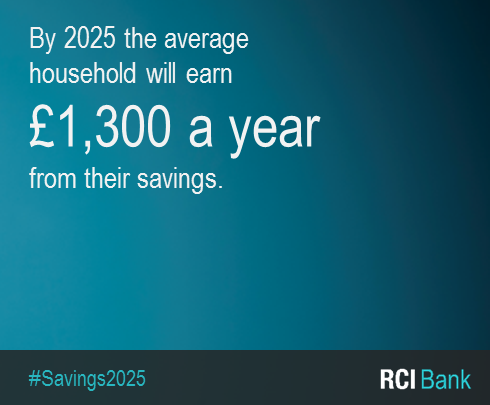


Household savings will grow by £500 billion to £1.8 trillion by 2025, economic analysis conducted by the Cebr (Centre for Economic and Business Research) on behalf of RCI Bank, has revealed. However, it will take ten years of income growth for monthly savings contributions to reach in real terms what they are today.
Whilst speculation mounts about how much longer the Bank of England can hold off raising the base rate, the Savings 2025 Report* for RCI Bank forecasts trends in savings over the next ten years. Average savings interest rates* are forecast to increase by 1 percentage point, up to an average rate of 2.3% by 2025 from the current 1.3% average savings rate. The report further forecasts on the back of expectations that the Bank of England base rate is likely to rise at the start of 2017. It will then rise to a steady state of 2% by the end of 2018, where it will remain static until 2025.
However, the report reveals that whilst savings and mortgage rates are expected to rise alongside the base rate, the ‘spread’ between these rates and the base rate is expected to shrink, meaning that savers won’t see all the benefits of the base rise. This is mainly due to lending conditions stabilising, as well as the overall changing nature of the UK economy.
Steve Gowler, CEO of RCI Bank, said: “It’s clear that the impact of any base rate rise will impact people in different ways. Those with loans or mortgages will see a few tough years as their disposable income falls as a result of stunted income growth. To protect themselves from any negative impacts of a base rate rise, we urge borrowers to start saving now and create a safeguard from repayments increases. As Mark Carney advises, people should start preparing for a potential base rate rise.”
Ten years of stunted income growth
By 2025 the average household saving pot is projected to increase by £11,700 to £58,700 in real terms (totalling £1.8 trillion across all households) up from £47,000 in 2015. This larger household savings pot, alongside higher interest rates would earn £1,300 in annual interest in 2025. This figure is more than double the current £600 that is being generated in 2015.
Breaking this down further, in 2025, average annual savings contributions are projected to stand at £3,800 in 2014 prices, only just ahead of that seen in 2015. This actually means that it will take ten years of income growth for savings contributions to reach again in real terms what they are today. This is directly because the amount households are saving on average will decrease once base rates rise, as those savers who are also borrowers will see their discretionary income (the money they have left over after all necessities have been paid for) fall. However, whilst monthly savings will slowly increase again, as incomes slowly rise over time but in real terms it will take ten years for these slow increases to bring the level of monthly saving back up to what we’ve got now.
Mortgages and savings
A potential base rate rise will create a complex picture. Two in ten (20%) of the adults surveyed say they would save more if interest rates started to rise, and 30% said a base rate rise means they would end up saving less. When asked why, 18% said it was out of fear that their monthly mortgage repayments would go up. This is a concern directly echoed by Mark Carney, who recently stated that one in 25 households with a mortgage is vulnerable to a rate hike, because the cost of paying off debts amounts to more than 40% of a household income.
Socio-economic trends
The Savings 2025 Report further reveals the majority of UK adults (66%) have indicated they would need to see savings interest rates reach higher peaks than those forecast over the next ten years to encourage an increase in savings. Half (50%) of UK adults stated they would need to receive an interest rate between 4% - 7% to drive more savings, whilst 28% stated no rate up to 7% would be sufficient enough for them to increase their monthly savings. However, further analysis revealed that people at the higher end of the socio-economic group (ABC1) are more likely to be encouraged to save more by a smaller increase in interest rates. Nearly four in ten in this bracket (38%) said a noticeable increase for them would be from 2% - 3%, compared to just 15% in the bottom half of the spectrum (C2DE).
Steve Gowler, CEO of RCI Bank, said: “For some people balancing mortgage repayments and higher borrowing costs whilst trying to save may become more difficult in the future, whilst those who are focusing on saving may find they do better.
“It’s also clear that a lot of consumers want more from their savings rates than is forecast to happen. Whilst savings rates are very unlikely to hit anywhere between consumers’ desired 4% - 7% in the next ten years, RCI Bank is committed to providing UK savers with a quick and easy way to save today, without forfeiting a great rate.”



